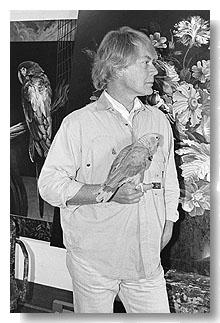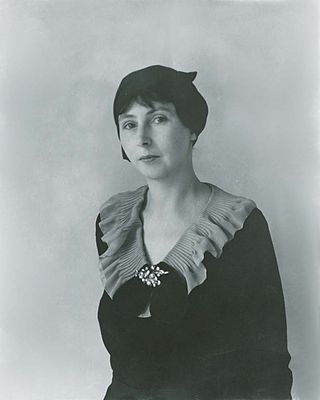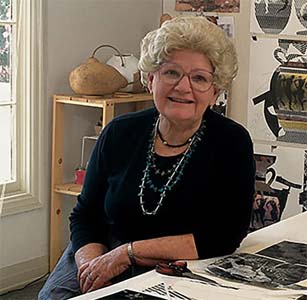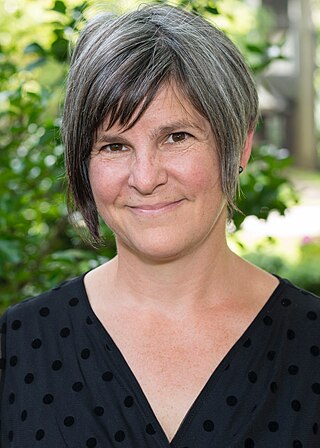
The Federal Art Project (1935–1943) was a New Deal program to fund the visual arts in the United States. Under national director Holger Cahill, it was one of five Federal Project Number One projects sponsored by the Works Progress Administration (WPA), and the largest of the New Deal art projects. It was created not as a cultural activity, but as a relief measure to employ artists and artisans to create murals, easel paintings, sculpture, graphic art, posters, photography, theatre scenic design, and arts and crafts. The WPA Federal Art Project established more than 100 community art centers throughout the country, researched and documented American design, commissioned a significant body of public art without restriction to content or subject matter, and sustained some 10,000 artists and craft workers during the Great Depression. According to American Heritage, “Something like 400,000 easel paintings, murals, prints, posters, and renderings were produced by WPA artists during the eight years of the project’s existence, virtually free of government pressure to control subject matter, interpretation, or style.”

The Freer Gallery of Art is an art museum of the Smithsonian Institution in Washington, D.C. focusing on Asian art. The Freer and the Arthur M. Sackler Gallery together form the National Museum of Asian Art in the United States. The Freer and Sackler galleries house the largest Asian art research library in the country and contain art from East Asia, South Asia, Southeast Asia, the Islamic world, the ancient Near East, and ancient Egypt, as well as a significant collection of American art.

Ian Hornak was an American draughtsman, painter and printmaker. He was one of the founding artists of the Hyperrealist and Photorealist fine art movements; credited with having been the first Photorealist artist to incorporate the effect of multiple exposure photography into his landscape paintings; and the first contemporary artist to entirely expand the imagery of his primary paintings onto the frames.

John D. Graham was a Ukrainian–born American modernist and figurative painter, art collector, and a mentor of modernist artists in New York City.

Betty Parsons was an American artist, art dealer, and collector known for her early promotion of Abstract Expressionism. She is regarded as one of the most influential and dynamic figures of the American avant-garde.

The Getty Research Institute (GRI), located at the Getty Center in Los Angeles, California, is "dedicated to furthering knowledge and advancing understanding of the visual arts".
Purvis Young was an American artist from the Overtown neighborhood of Miami, Florida. Young's work, often a blend of collage and painting, utilizes found objects and the experience of African Americans in the south. Young gained recognition as a cult contemporary artist, with a collectors' following that included Jane Fonda, Damon Wayans, Jim Belushi, Dan Aykroyd, and others. In 2006 a feature documentary titled Purvis of Overtown was produced about his life and work. His work is found in the collections of the American Folk Art Museum, the Corcoran Gallery of Art, the High Museum of Art, the National Museum of African American History and Culture, the Pérez Art Museum Miami, the Philadelphia Museum of Art, the Bakehouse Art Complex, and others. In 2018, he was inducted into the Florida Artists Hall of Fame.
Robert Ebendorf is an American metalsmith and jeweler, known for craft, art and studio jewelry, often using found objects. In 2003–2004, the Smithsonian American Art Museum organized an exhibition of 95 pieces, titled The Jewelry of Robert Ebendorf: A Retrospective of Forty Years.

Margaret Frances Bacon was an American artist, best known for her satirical caricatures.

Smithsonian Libraries and Archives is an institutional archives and library system comprising 21 branch libraries serving the various Smithsonian Institution museums and research centers. The Libraries and Archives serve Smithsonian Institution staff as well as the scholarly community and general public with information and reference support. Its collections number nearly 3 million volumes including 50,000 rare books and manuscripts.

William Schaus was an American entomologist who became known for his major contribution to the knowledge and description of new species of the Neotropical Lepidoptera.

Katherine Westphal was an American textile designer and fiber artist who helped to establish quilting as a fine art form.
Paul J. Smith was an arts administrator, curator, and artist based in New York. Smith was professionally involved with the art, craft, and design fields since the early 1950s and was closely associated with the twentieth-century studio craft movement in the United States. He joined the staff of the American Craftsmen's Council in 1957, and in 1963 was appointed Director of the Museum of Contemporary Crafts, a position he held for the next 25 years. In September 1987, he assumed the title of director emeritus and continued to work as an independent curator and consultant for museums, arts organizations, and collectors.

Beth Lipman is a contemporary artist working in glass. She is best known for her glass still-life compositions which reference the work of 16th- and 17th-century European painters.
Bernard Chaet was an American artist; Chaet is known for his colorful, dynamic modernist paintings and masterful draftsmanship, his association with the Boston Expressionists, and his 40-year career as a professor of painting at Yale University. His works also include watercolors and prints. In 1994, he was named a National Academician by the National Academy of Design.

The Boris Mirski Gallery (1944–1979) was a Boston art gallery owned by Boris Chaim Mirski (1898–1974). The gallery was known for exhibiting key figures in Boston Expressionism, New York and international modern art styles and non-western art. For years, the gallery dominated with both figurative and African work. As an art dealer, Mirski was known for supporting young, emerging artists, including many Jewish-Americans, as well as artists of color, women artists and immigrants. As a result of Mirski's avant-garde approach to art and diversified approach to dealing art, the gallery was at the center of Boston's burgeoning modern mid-century art scene, as well as instrumental in the birth and development of Boston Expressionism, the most significant branch of American Figurative Expressionism.
Melvin Joel Zabarsky (1932–2019) was an American figurative painter who created representational work in the narrative tradition. Known for a bright, bold palette, his work often explores political, historical and cultural themes to surreal and realist effect. In a six-decade career marked by several distinct phases, Zabarsky's imaginative use of color, formal experimentation and commitment to narrative organization in both traditional and avant garde styles are hallmarks of his work. In an interview with the British philosophers Donald and Monica Skilling, he said, "I'm discovering history, or a narrative, within a painting, as I go along."
Joyce Reopel (1933–2019) was an American painter, draughtswoman and sculptor who worked in pencil, aquatint, silver- and goldpoint, and an array of old master media. A Boris Mirski Gallery veteran, from 1959 to 1966, she was known for her refined skills and virtuosity. She was also one of very few women in the early group of Boston artists that included fellow artist and husband Mel Zabarsky, Hyman Bloom, Barbara Swan, Jack Levine, Marianna Pineda, Harold Tovish and others who helped overcome Boston's conservative distaste for the avant-garde, occasionally female, and often Jewish artists later classified as Boston expressionists. Unique to New England, Boston Expressionism has had lasting local and national influence, and is now in its third generation.
Nanette L. Laitman was an art collector and philanthropist. She has been involved with the board of the Museum of Arts and Design (MAD) and its precursors in New York City for over 25 years. She became a member of the board in 1994 and board president in 2000. She was one of the main benefactors supporting MAD's relocation to 2 Columbus Circle in 2002. Laitman has also funded the Nanette Laitman Documentation Project for Craft and Decorative Arts in America at the Smithsonian's Archives of American Art.
Jim Melchert was an American visual artist, arts administer, and professor. He known for his ceramics and sculptures. Melchert was part of the Funk art movement.












